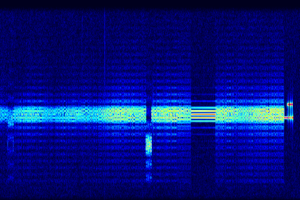Experimental Modes
Since 2008, the Russian 7 operator has possessed a digital system containing many multicarrier PSK and FSK waveforms. While this system has been active semi-regularly for many years, it is considered experimental for the following reasons:
- Lack of use on long-term regular schedules following the standard habits of this operator.
- Activity in groups of daily, hourly transmissions, each made using a different mode. Such groups typically include XPA and XPA2 as well.
- Mode variants appearing and disappearing over the years.
| Mode | Spectrogram | Sample | Notes | Since |
|---|---|---|---|---|
| 8 x 62.5 Bd QPSK + 250 Bd BPSK |
 |
Data: N blocks, each of the following structure:
|
2008 | |
| 2 x 62.5 Bd QPSK + 250 Bd BPSK |
 |
Data: N blocks, each of the following structure:
|
2019 | |
| 8 x 62.5 Bd QPSK |  |
Intro: Two-second two-tone sequence repeated for two minutes. Data: Eight parallel 62.5 Bd QPSK streams, in 12288 ms blocks. |
2018 | |
| 2 x 62.5 Bd QPSK |  |
Intro: Two-second two-tone sequence repeated for two minutes. Data: Two parallel 62.5 Bd QPSK streams, in 12288 ms blocks. |
2008 | |
| 5 x 10 Bd 16FSK + 250 Bd BPSK |
 |
Data: N blocks, each of the following structure:
|
2013 | |
| 10 Bd 16FSK + 250 Bd BPSK |
 |
Data: N blocks, each of the following structure:
|
2016 | |
| 10 Bd 16FSK + 125 Bd BFSK |
 |
Data: N blocks, each of the following structure:
|
2016 | |
| ~15.625 Bd BFSK |  |
An idle signal that carries no data. Structure: A 2000 Hz tone (63.75 ms) followed by a 1000 Hz tone (64 ms), repeated altogether for 3 minutes. |
2015 |
